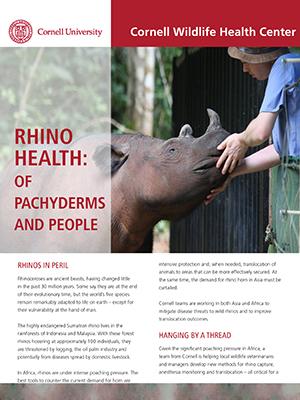Translocation of Black Rhinos
Hanging by a thread: safely transporting rhinos
In Africa, rhinos are under intense poaching pressure. The best tools to counter the current demand for horn are intensive protection and, when needed, translocation of animals to areas that can be more effectively secured. At the same time, the demand for rhino horn in Asia must be curtailed. Our teams are working in Africa to improve translocation outcomes that support conservation efforts.
Based on physiological research pioneered by Cornell veterinarians, we are helping local wildlife veterinarians and managers in Africa develop new methods for rhino capture, anesthesia monitoring, and translocation. One technique to move rhinos to safety is by slinging them upside down under a helicopter. Namibia is now employing the technique, as is South Africa, which appears to be the safest way to move an anesthetized rhino out of rugged terrain. This will help improve success rates when intensive management is the only hope for protecting rhinos from poachers and maximizing genetic diversity among remaining animals—all critical for a sustained fight to secure a future for these extraordinary animals.













